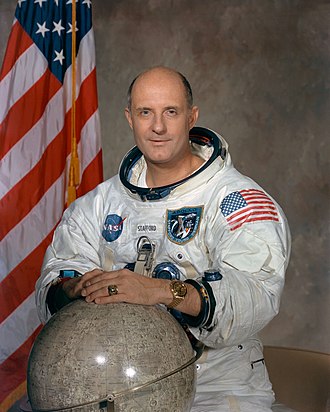Thomas P. Stafford
Thomas Patten Stafford (September 17, 1930 – March 18, 2024) was an American former Air Force officer, test pilot, and NASA astronaut.
Thomas P. Stafford | |
|---|---|
 Thomas Stafford (1969) | |
| Born | Thomas Patten Stafford September 17, 1930 Weatherford, Oklahoma, U.S. |
| Died | March 18, 2024 (aged 93) Satellite Beach, Florida, U.S. |
| Resting place | Weatherford, Oklahoma, U.S. |
| Nationality | American |
| Other names | Thomas Patten Stafford |
| Alma mater | United States Naval Academy, B.S. 1952 |
| Occupation | Test pilot, consultant |
| Awards | |
| Space career | |
| NASA Astronaut | |
| Rank | United States Air Force |
Time in space | 21d 03h 42m |
| Selection | 1962 NASA Group 2 |
| Missions | Gemini 6A, Gemini 9A, Apollo 10, Apollo–Soyuz Test Project |
Mission insignia | |
| Retirement | November 1, 1979 |
Stafford was an officer in the United States Air Force. He flew F-86 Sabres before becoming a test pilot.
He was became an astronaut in 1962, and flew aboard Gemini 6A and Gemini 9A.
In 1969, Stafford was the Commander of Apollo 10, the second crewed mission to orbit the Moon. Apollo 10 was also the first to fly a Lunar Module in lunar orbit. It flew very close to the Moon, going down to an altitude of nine miles.
In 1975, Stafford was the commander of the Apollo-Soyuz Test Project flight, the first joint U.S.-Soviet space mission.[1]
Stafford died from liver cancer at a care home in Satellite Beach, Florida on March 18, 2024, at the age of 93.[2][3]
Thomas P. Stafford Media
Stafford (left) with his Gemini 6A crewmate Wally Schirra (1965)
Stafford (right) and Eugene Cernan arrive aboard USS Wasp (1966)
Stafford as Apollo 10 Commander (1969)
Historic handshake of Stafford (right) and cosmonaut Alexei Leonov during Apollo–Soyuz (1975)
Stafford was presented with the Medal "For Merit in Space Exploration" from Russian President Dmitry Medvedev on April 12, 2011, at the Moscow Kremlin
References
- ↑ "Lieutenant General Thomas P. Stafford". United States Air Force. February 1979. Retrieved 7 February 2018.
- ↑ Pearlman, Robert (March 18, 2024). "Thomas Stafford, astronaut who led Apollo-Soyuz mission, dies at 93". collectSpace. Archived from the original on March 18, 2024. Retrieved March 18, 2024.
- ↑ Goldstein, Richard (March 18, 2024). Thomas Stafford, 93, Commander of First U.S.-Soviet Space Mission, Dies. https://www.nytimes.com/2024/03/18/science/space/thomas-p-stafford-dead.html. Retrieved March 18, 2024.





